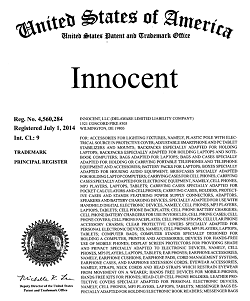Trademark Registration
Take advantage of experience with trademark registration. Avoid research and save your time. Order trademark help from us.
Form and Fees
Why Register a Trademark?
What can I register as a trademark?
From slogans, strap-lines, buy-lines, logos, designs to shapes, colours and smells and any available name that complies with the legal requirements can be registered as trademark for a product or for a service.
What are the benefits of a trademark?
If you own a trademark, your business gains in value. You can stop others from using similar logos or slogans. You can license your trademarks. You can use the prestigious label “
Why us?
What our competitors do not offer:
| TOTAL (£) incl IPO official fee and VAT |
|
|---|---|
| UK (1 class included) | £269 Additional Class: £75 |
| EU (1 class included) | £890Additional Class: £145 |
| USA (1 class included) | £399Additional Class: £299 |
| International (1 class included) | £899Additional Class: £199 Each Additional Country: £299 |
| Search: ONE of the following UK, USA, EU or other country | £99 |
| TWO of the following UK, USA, EU, WIPO or other country PLUS additional services | £299 |
| THREE of the following UK, USA, EU, WIPO or other country PLUS additional services | £499 |
How does it work?
The most important questions you need to ask!
More classes higher fees
The fees for trademark registration increase with each class of products or services, for which the trademark is registered. There are 45 classes of trademark. Owners of the trademarks usually select 2 or 3 classes. Classification of products and services is the same around the world, because states are bound by international conventions.
More countries higher fees
One of the issues with protection of marks or logos is also the choice of the number of countries, in which will the trademark or logo be protected. Is enough one country, or is it better to file the protection throughout the EU? Is enough to protect your mark or logo in the US and EU, or is it better to extend protection to China? Owners of the mark or logo usually do not choose China and other countries, where the subsequent enforcement of intellectual property rights of trademark is low.
Image or Word
When you want to register your trademark the difficult question is to decide whether to protect only your brand as a word or the logo as an image or both as a combination, or each of them by two separate trademarks. In the application procedure it is easier to get the protection of an image or a combination of word and image. However, the protection of word in combined trademark is weaker because it is protected only in conjunction with an image. The second disadvantage of the image trademark or combined trademark is that the logo may be partially or substantially changed over time, whereby the greater the change of the former logo is, the lesser the new logo and the word is protected by the former trademark. The advantage of purely verbal marks is the force of the protection; hence the word is completely monopolized by its owner. Other entities have to use or register this word.
Conflict with earlier marks
Another problem with trademark registration is to check whether your brand or logo has been registered by someone else. It is required to check before the trademark registration, whether there is in the individual states or at EU level a trademark with the same or similar wording or illustrations. If the application for trademark registration includes the brand or logo identical or similar to an earlier trademark or logo, the trademark application will be rejected and registration fees will not be returned.
Where to register a trademark?
When registering a trademark, you have to choose countries where the trademark will be protected. An important issue to consider is also the fees for registration in each country, where the trademark will be protected. Most common trademark registrations are:
- – UK Trademark
- – EU Trademark (trademark valid for the whole EU)
- – US Trademark
- – International Trademark
- – states where the firm is active or where it will offer and sell services or goods.
Applicants usually don’t choose China and other countries where the subsequent enforcement of intellectual property rights is weak.
International Trademark
One of the advantage of International Trademark is the possibility to apply simultaneously in several countries. The disadvantage is that except the fees for international trademark, you have to pay the fees for the some national trademarks. The list of countries where it is possible to file an International Trademark is defined by the Nice Agreement Concerning the International Classification of Goods and Services for the Purposes of the Registration of Marks.

